Bitcoin has reached a new high, driving activity in the DeFi market, with SynFutures becoming the focus of the derivatives track on the Base network.
Author: Sha
I. When DeFi Becomes the Trend Again
Bitcoin finally reached a long-awaited new high in November, not far from the 100,000 mark, while the long-dormant altcoin market has also seen an explosion, with DeFi leaders like UniSwap, AAVE, Compound, and MakerDAO recently experiencing significant gains. Looking back at the DeFi explosion in 2020, despite ongoing pessimistic voices, the DeFi world continues to develop and expand steadily, gradually eating into the market share of centralized exchanges. This remains a track full of innovation and immense potential, with many possibilities waiting to be explored. Today, I want to discuss one of the projects in the recent DeFi ecosystem that I believe is worth paying attention to — SynFutures, the leader in derivatives on Base. We will explore how it combines its advantages to lead a new round of DeFi innovation, how it stirs the entire decentralized derivatives track, and the reasons behind its rapid growth and future growth potential.
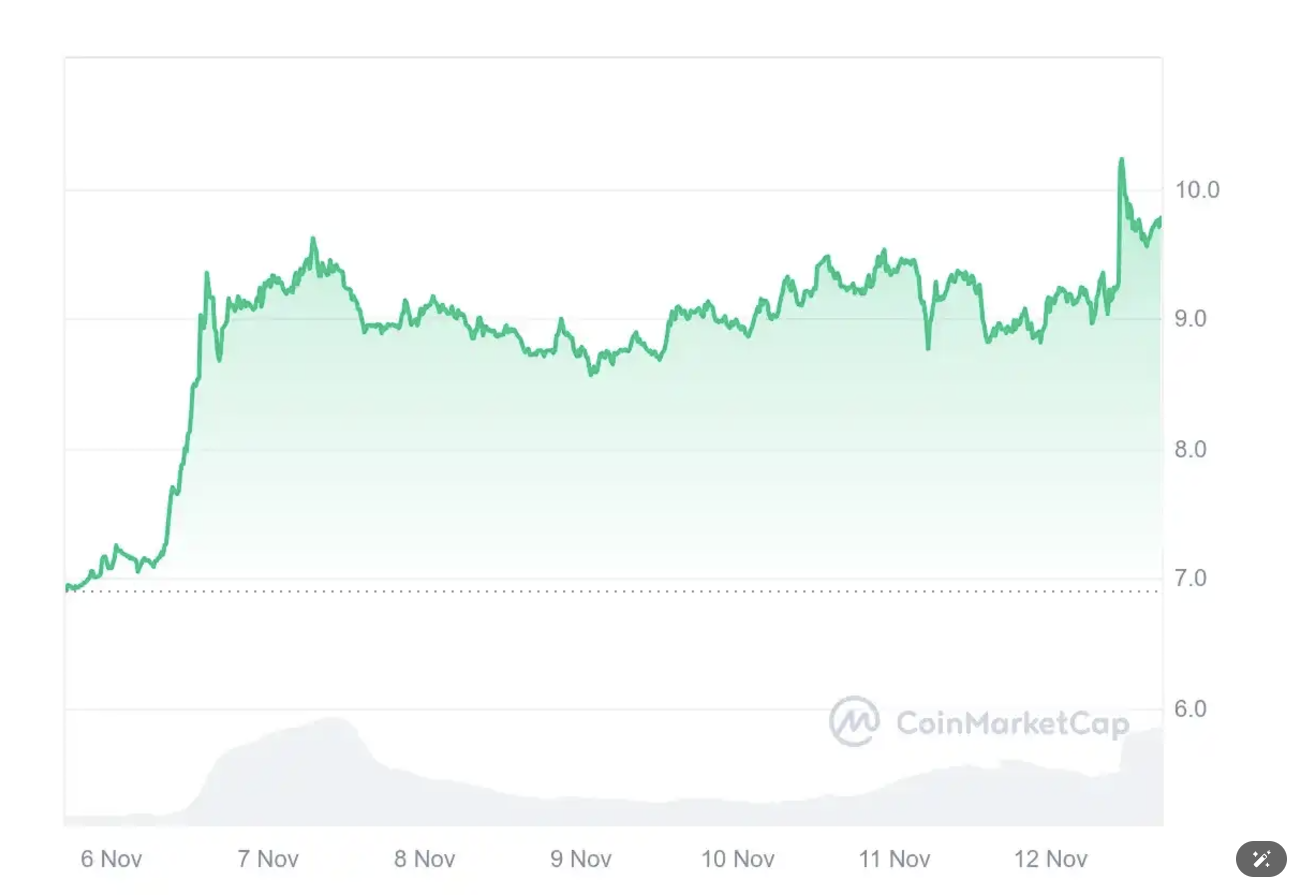
II. Performance of SynFutures After Launching on Base: Capturing 50% Market Share, Ranking 3rd in Protocol Fee Revenue
Let’s first look at the data performance of SynFutures in the Base derivatives track:
Launched on Base on July 1, and within 10 days, the trading volume exceeded 100 million USD.
On November 12, the trading volume surpassed 910 million USD.
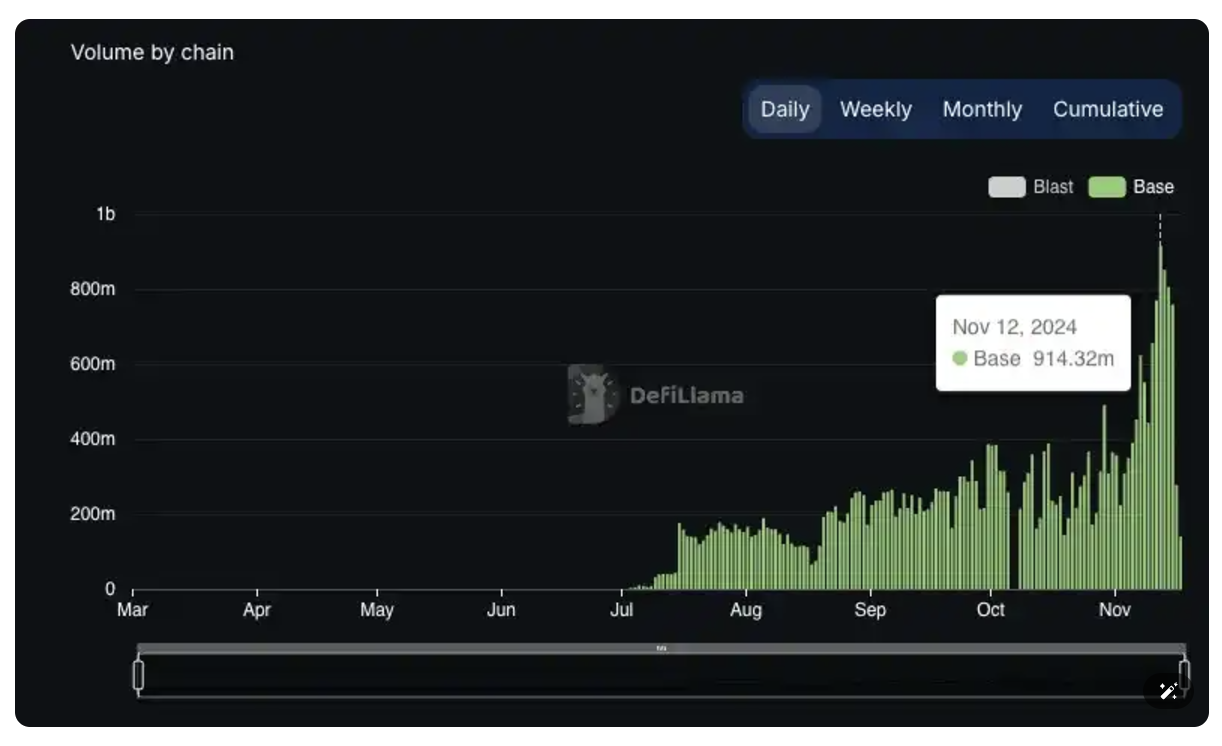
- Cumulative trading volume is close to 30 billion USD, with an average daily trading volume of 210 million USD.
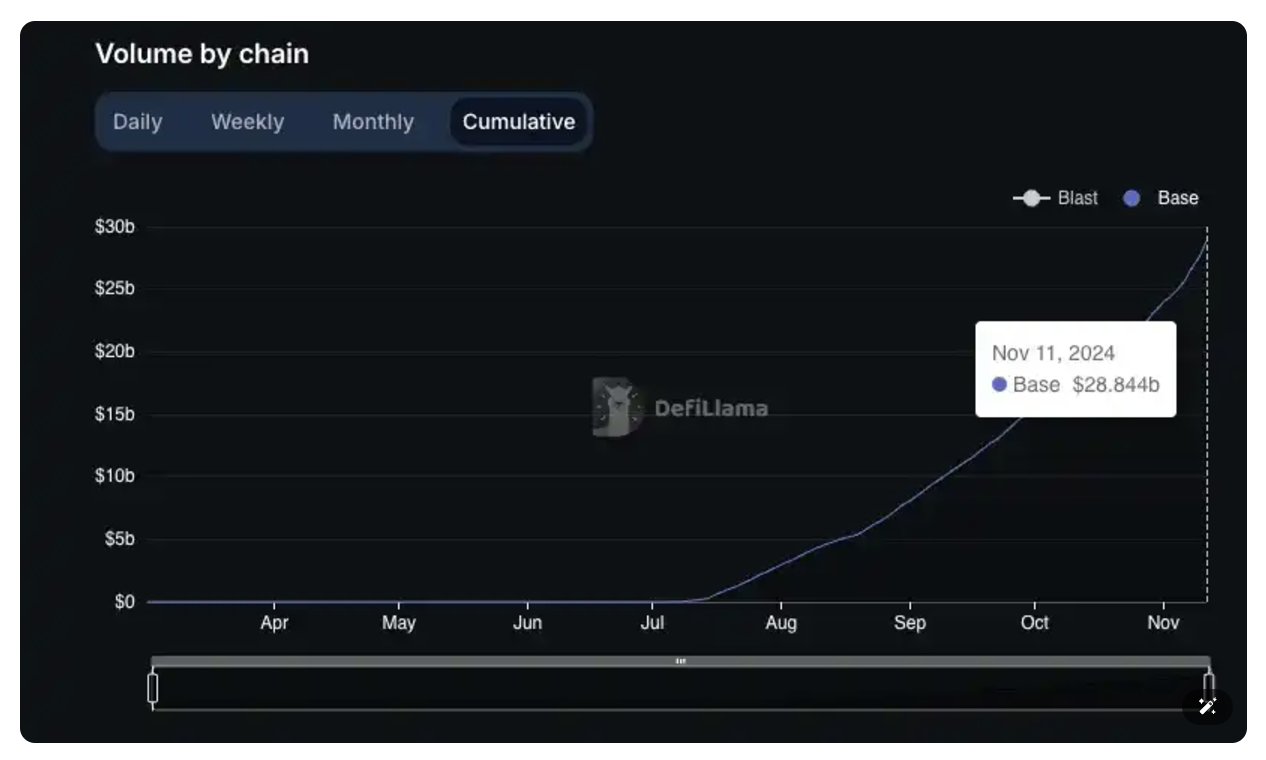
- In Q3, trading volume accounted for nearly 50% of the Base network.
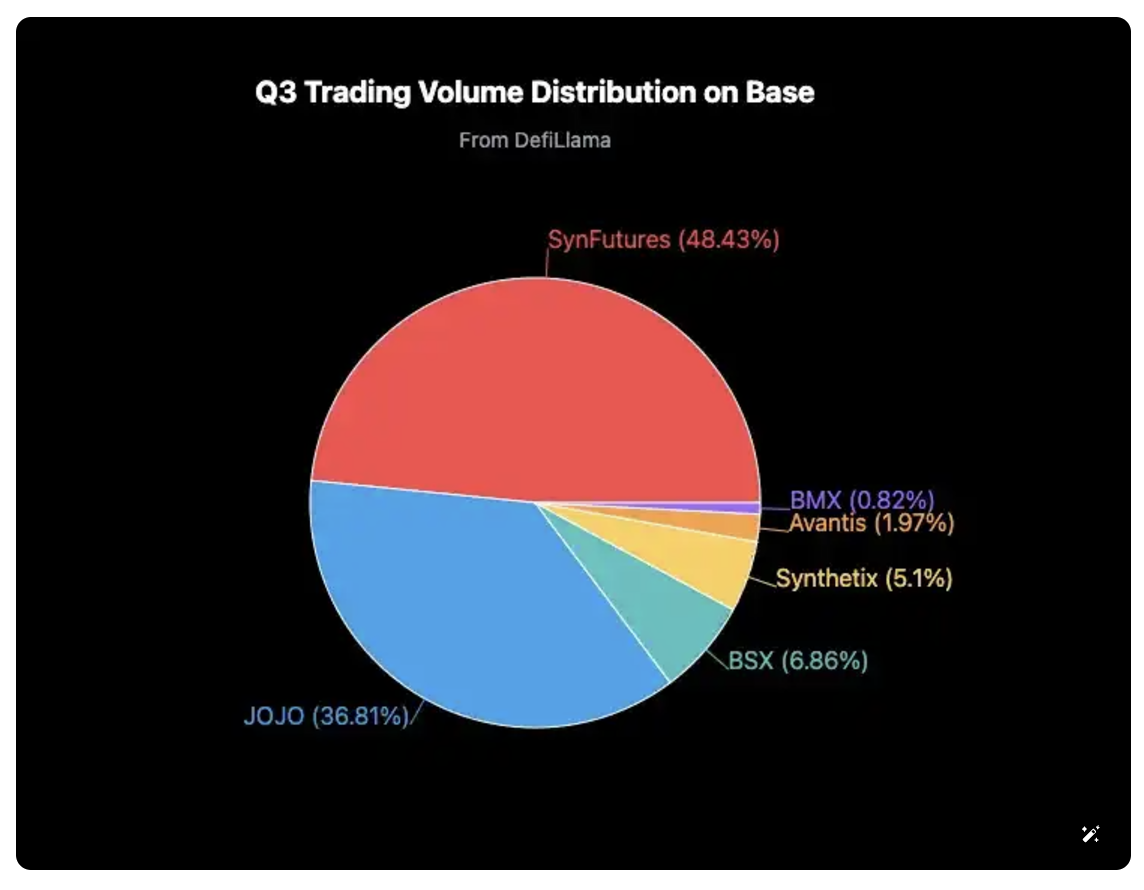
- In the past 24 hours, trading volume accounted for 72% of the Base network, nearly five times that of the second place.
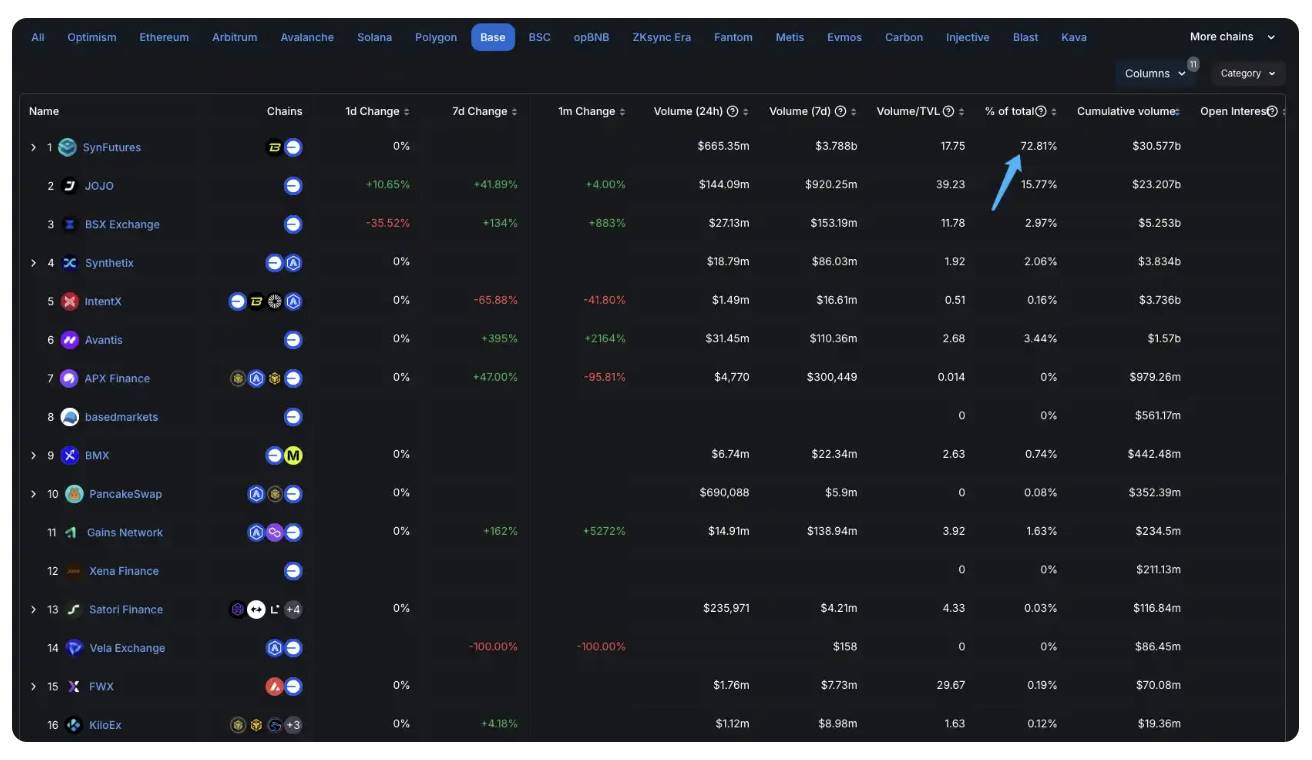
If we broaden our perspective to the entire industry, we can see the growth of SynFutures V3 since its launch, which is comparable to projects like Hyperliquid, dYdX, and Jupiter. According to DefiLlama data, the on-chain perpetual contract trading volume in Q2 and Q3 was 1.1857 trillion USD, with the top three accounting for over 45% of the trading volume: Hyperliquid (16.94%), dYdX V3 & V4 (14.37%), and SynFutures (14.11%).
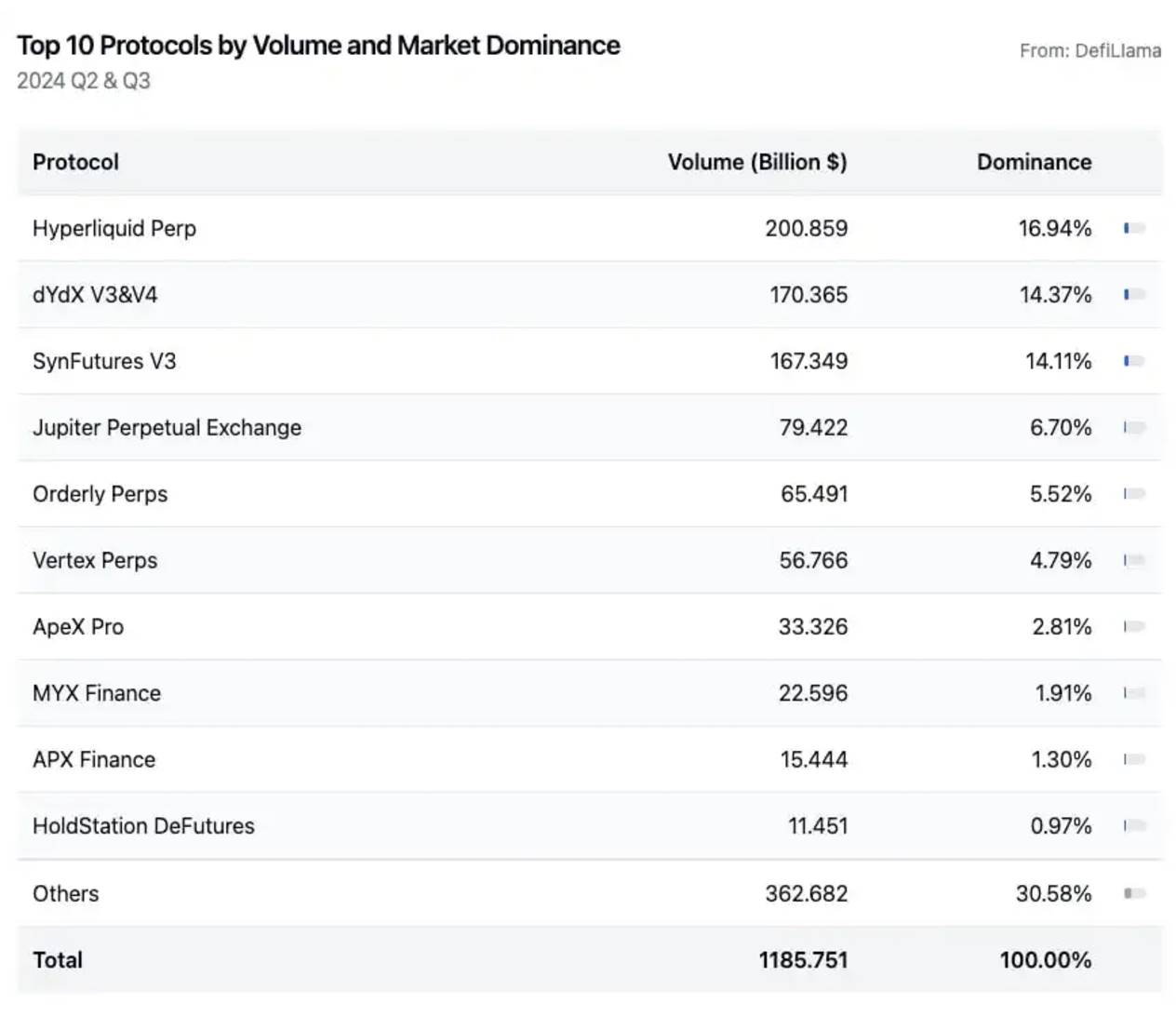
These impressive results raise curiosity about why SynFutures, and what unique aspects it has compared to other derivatives platforms.
III. The Breakthrough Player in the Derivatives Track: SynFutures — Concentrated Liquidity + Pure On-Chain Order Book Model
Looking back at the derivatives track over the past few years, the mainstream derivatives models can be categorized into three types:
The Vault model represented by GMX — LPs act as counterparties to traders and use oracle pricing. The representative products in this track are GMX and Jupiter. GMX supports more assets, while Jupiter benefits from the popularity of SOL, maintaining high yields and high TVL, becoming one of the industry's hot projects. However, the oracle risk in this model remains a significant concern, and due to the use of oracle pricing, it cannot serve as a price discovery venue, making it difficult to challenge centralized exchanges.
The derivatives application chains represented by dYdX and Hyperliquid — favored by market makers for their high performance and centralized exchange-like experience, they hold a place in the market. However, the overly centralized nature of their off-chain order books and the issue of fragmented liquidity remain significant challenges for traders and project parties.
A more low-profile but already achieving good market share model is the on-chain AMM model represented by SynFutures. This model references the concentrated liquidity model of UniSwap V3 and introduces an on-chain order book to further enhance the overall capital matching efficiency. From the previous Q2 and Q3 trading volume rankings, it can be seen that SynFutures, as a representative of this model, has trading volume more than double that of Jupiter, which uses the Vault model. This momentum shows no signs of stopping, and recent data indicates that surpassing the long-established decentralized derivatives exchange dYdX in total trading volume is only a matter of time.
So, why has the on-chain AMM model represented by SynFutures achieved such a significant breakthrough in a short time? What advantages does this model have compared to the other two mainstream models?
3.1 Concentrated Liquidity — Improving Capital Efficiency
SynFutures' oAMM allows LPs to add liquidity to specified price ranges, greatly enhancing the liquidity depth and capital utilization efficiency of the AMM, supporting larger and more transactions while creating more fee income for LPs. According to its documentation, its capital efficiency can reach up to 26,666.6 times the original.
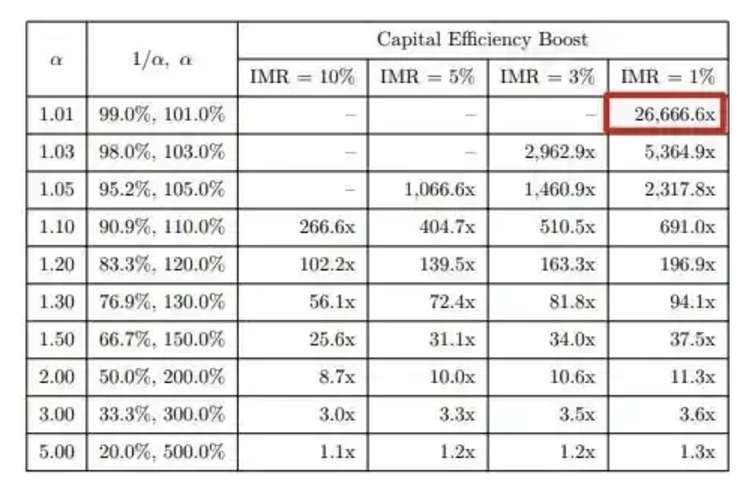
3.2 Pure On-Chain Order Book — Maintaining Efficiency While Ensuring Openness and Transparency
The liquidity of the oAMM is distributed across specified price ranges, which are composed of several price points. For example, if an LP provides liquidity in the BTC-USDC-PERP range of [80000, 90000], this price range can be divided into several price points, each allocated an equal amount of liquidity. You might immediately think, isn’t this just an order book? Exactly!
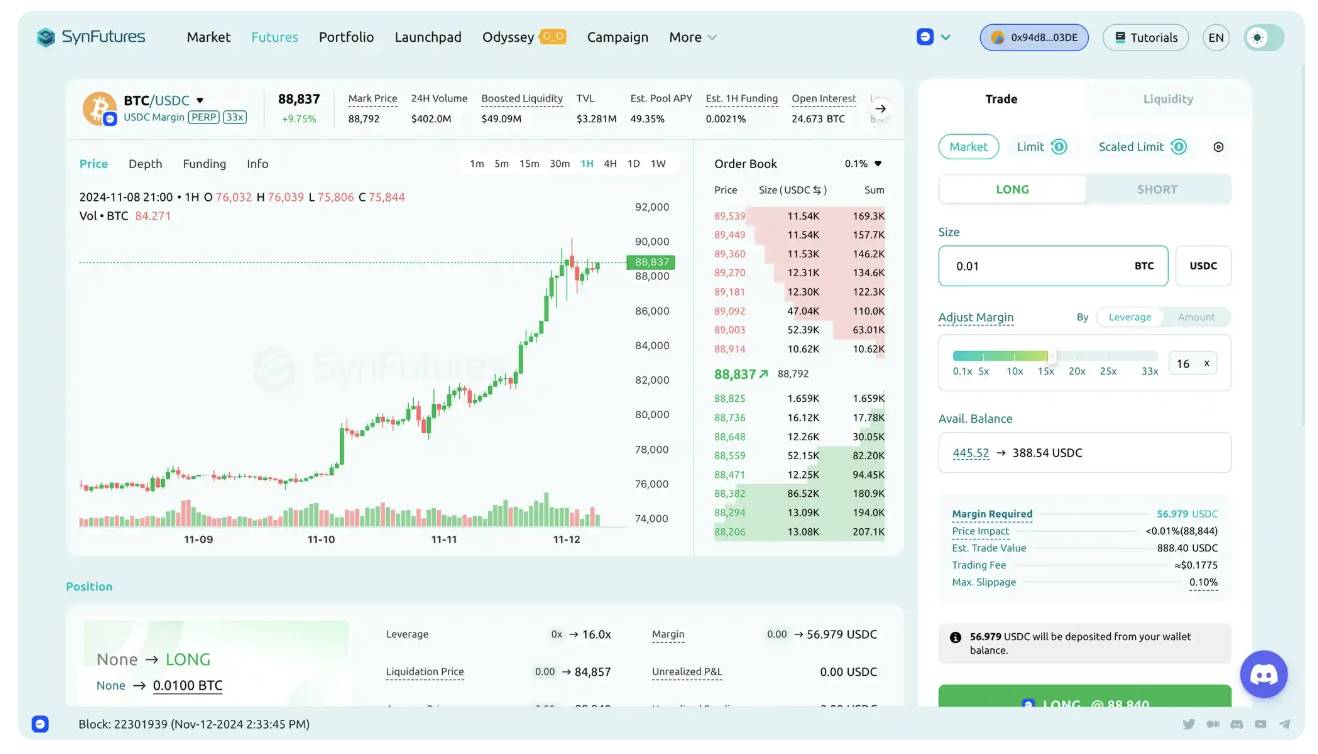
The oAMM allows users to provide liquidity at specified price points, simulating order book trading behavior and further improving capital efficiency. Compared to the market-making approach of traditional AMMs, market makers on centralized trading platforms are more familiar with and willing to participate in limit orders. Therefore, the oAMM, which supports limit orders, can better attract market makers to engage in proactive market making, further enhancing the trading efficiency and depth of the oAMM, achieving a trading experience comparable to centralized trading platforms.
Unlike off-chain order books like dYdX, the oAMM is deployed as a smart contract on the blockchain, with all data stored on-chain, allowing anyone to verify it, making it completely decentralized. Users need not worry about issues like dark operations or false trading by the trading platform.
When comparing several projects, it becomes clear that SynFutures effectively compensates for the shortcomings of the Vault model represented by GMX and the application chain represented by dYdX, while retaining high efficiency and performance. Additionally, it can naturally integrate with various assets of the underlying public chain, embedding itself into the entire DeFi ecosystem, giving it a natural advantage. As the underlying public chain undergoes technological upgrades in the future, this advantage will become even more pronounced.

IV. The Flywheel Effect Brought by Perp Launchpad
In addition to the characteristics of the model itself, SynFutures has also referenced the Pump.fun model to launch the industry's first perpetual contract issuance platform for derivatives. Over the past year, it can be said that the most profitable track has been asset issuance, from runes to inscriptions, from Pump.Fun to DAO.FUN, all of which have continuously created wealth effects, attracting more users to enter the market. This inevitably makes some friends who firmly believe in the value of blockchain feel disillusioned. But this is the reality of the current stage of the industry; whoever can engage in asset issuance, attract market attention, and create wealth effects can ride the wave and become a trendsetter. Whether it’s the success of Solana at this stage or the hundreds of millions of dollars in revenue from Pump.Fun, they are the best proof of this model. The Perp Launchpad recently launched by SynFutures is built on its model innovation and new asset issuance methods, enabling more on-chain Degen players to explore new innovative products.
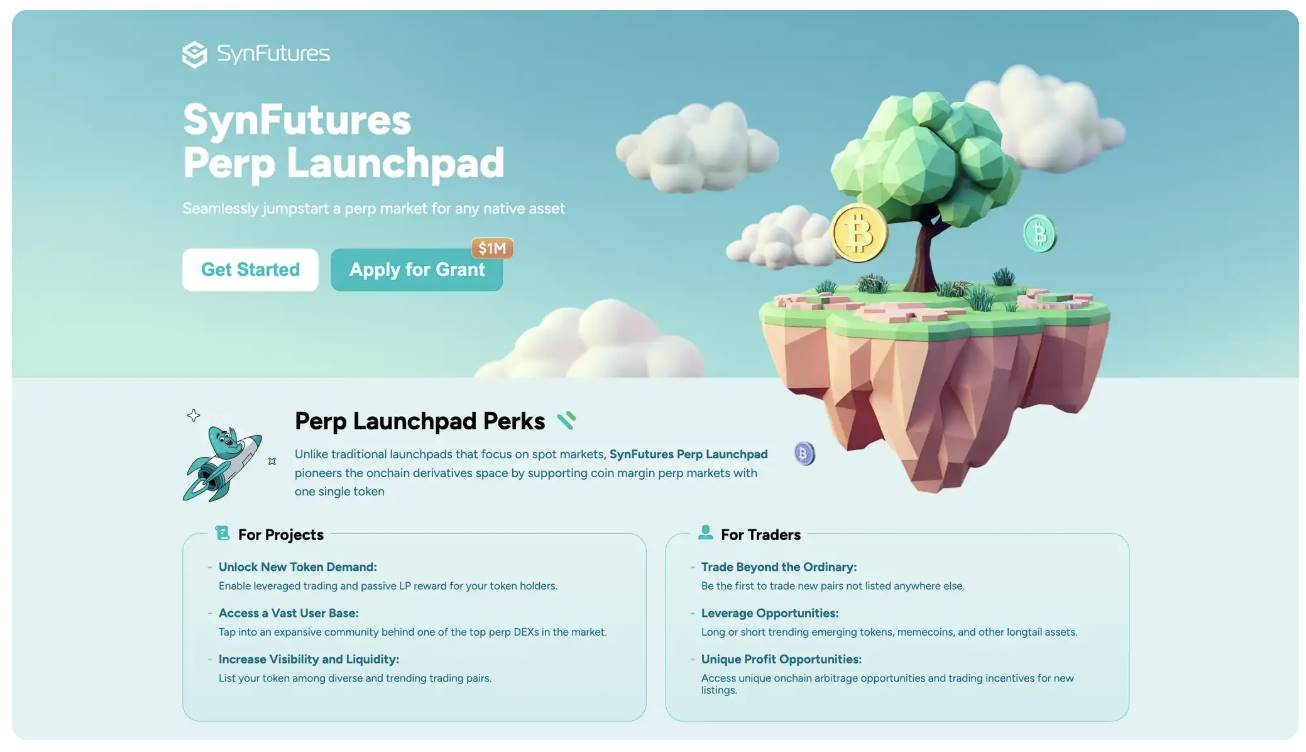
Imagine a MEME token that has just reached 100 million USD, which can provide liquidity using its own project token and open a corresponding contract market. Wouldn't that be more fun? If Truth of Terminals could have opened a contract market early on using its held $GOAT, more aggressive traders could choose to leverage their positions for higher returns, whether to buy the dip or sell the top. When a contract market exists, trading often becomes more complex and offers more trading opportunities. Additionally, in a highly volatile market, arbitrageurs will also emerge due to the price differences between spot and contract prices, further increasing the token's visibility and holder count.
Using the previous example, if Truth of Terminals really opened a Perp Market with $GOAT, there would be a new narrative: "AI has launched its own contract market," which could sustain market enthusiasm. Perhaps the market cap of $GOAT could rise even further. After all, what this market needs most is dopamine, fun, and excitement, and contract trading is one of the most entertaining means.

Of course, some may ask, who will provide liquidity? The answer is the project team and token supporters, who can earn rewards by providing liquidity — more tokens. When holders possess more tokens, the project can develop in a healthier direction. More importantly, why should we wait for centralized exchanges to dominate whether to launch corresponding contracts and take most of the profits generated from contract trading? Why can't the project team and community hold their own contract market? This is precisely what Perp Launchpad aims to do: return the control of the contract market to the community.

In the past few years, we have seen the control of listing spot tokens return to the community, with on-chain liquidity pools as the starting point, especially evident in MEME trading. In the coming years, the control of listing contract tokens will also return to the community. This may sound crazy, but it is already happening and will accelerate. From SynFutures' recent announcements, we can see that its Perp Launchpad surpassed 100 million USD in trading volume within its first week and is still growing rapidly.
In the future, we will see more project teams choosing to dominate their own derivatives markets after listing on the spot market, controlling the liquidity of the derivatives market, and using the profits gained to help the project develop or return to holders, entering a more virtuous and healthy development state. "Trading as Margin" will become one of the token's utilities, and "dividends" will become a standard feature of tokens. All of this is happening vigorously under the promotion of SynFutures.
When this wildfire ignites, for SynFutures, it will be like providing a huge pump, greatly benefiting its TVL and trading volume growth, bringing it closer to the leading position in the derivatives track. Returning the control of the perpetual contract market to on-chain and to the community represents a market worth at least 1 billion USD. Taking the Base network as an example, Aerodrome currently has a TVL of 1.4 billion USD. Even if only 1/10 of the funds choose to have their own derivatives market, that would still be close to 150 million USD in TVL. And this is just the TVL of one protocol on the Base network. Looking at the entire market, currently, only SynFutures can achieve this, and its oAMM designed specifically for contract trading will be the biggest beneficiary of this trend.
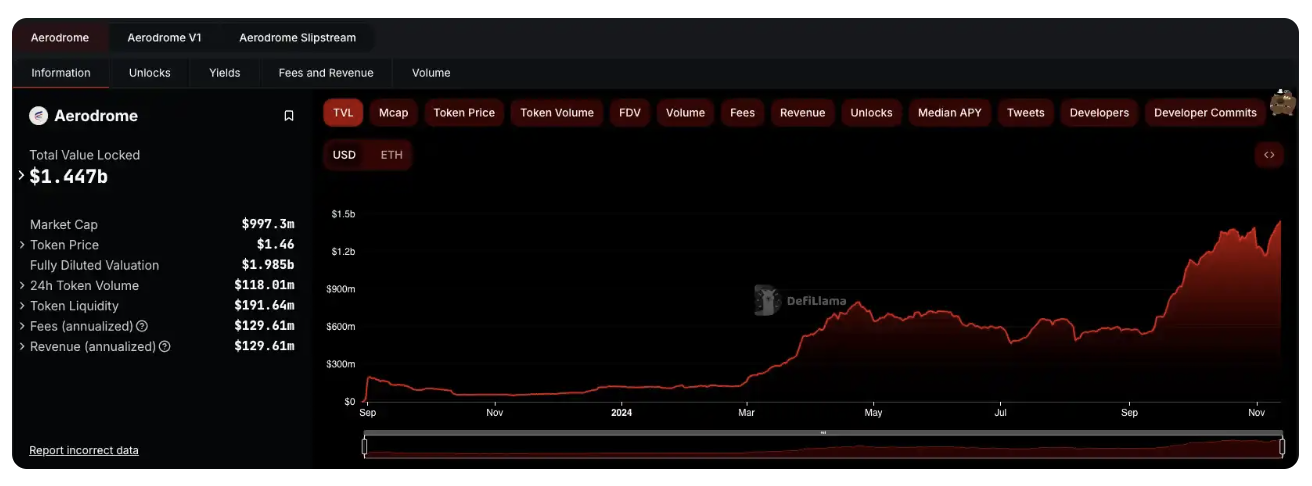
On the revenue side, SynFutures also has the opportunity to stand shoulder to shoulder with top protocols like AAVE and MakerDAO in the future. Currently, without considering the Launchpad, its fee revenue over the past 30 days has exceeded 200,000 USD, ranking 3rd in the protocol (the 3rd place is the Sequencer of the Base network).
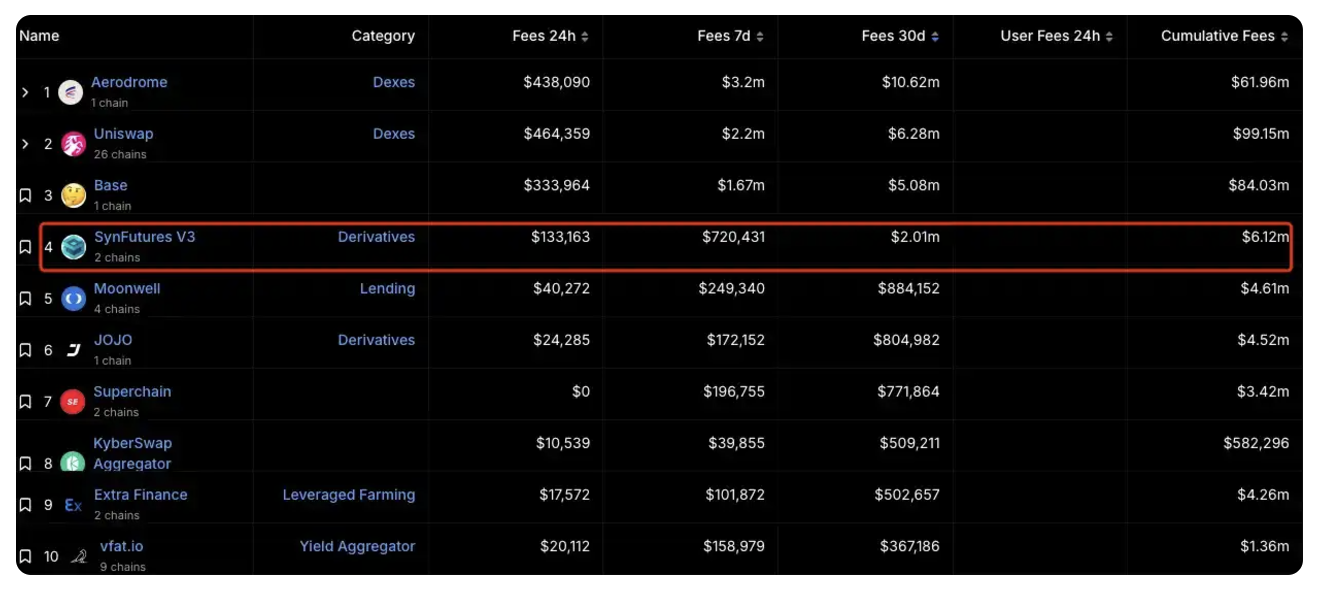
These potential revenues can help SynFutures quickly expand its market share in the Perp Launchpad, becoming a leader in this track. In the first phase of the Grant, SynFutures has set up a funding plan of 1 million USD, aimed at providing listing support, event support, and more for emerging projects, while helping projects enhance their exposure and activity in the on-chain market.
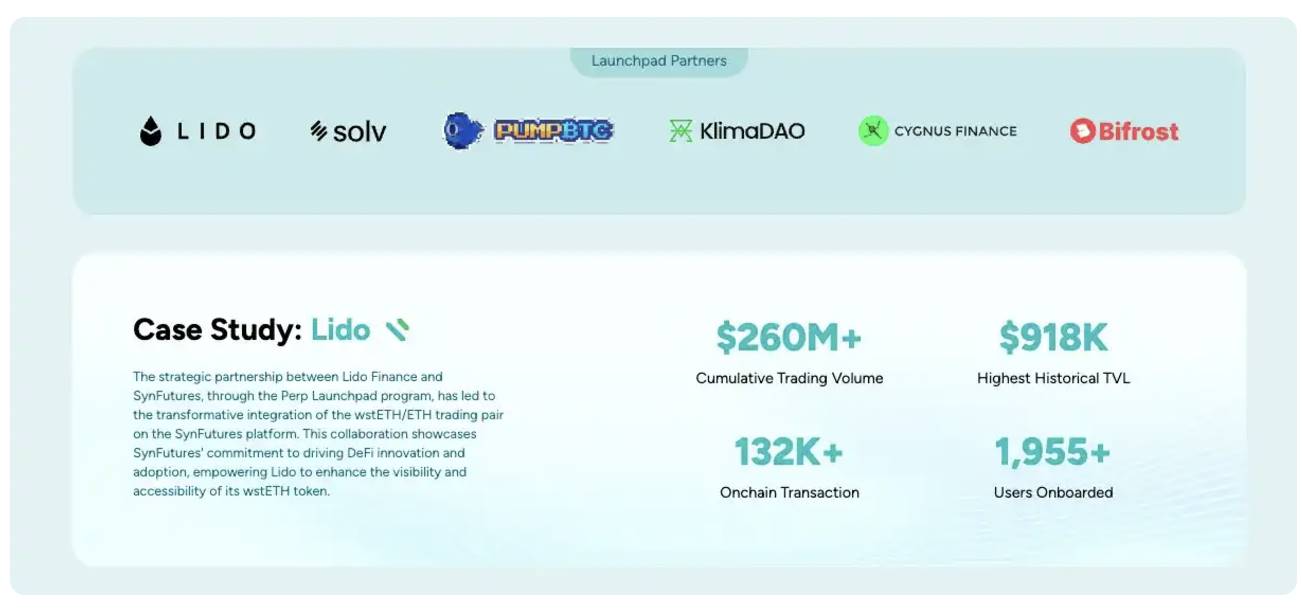
As more project teams join, they can help SynFutures gain more support from project communities, which means more users and more revenue. This further helps SynFutures expand its market influence and establish a growth flywheel. This is still without considering the incentives of its token economic model for the ecosystem. Let’s not forget that SynFutures has also raised 38 million USD from well-known industry institutions such as Pantera, Polychain, Dragonfly, Standard Crypto, and Framework, and the potential incentives of its future tokens and their impact on the growth flywheel will reach astonishing levels.
V. SynFutures Will Lead a New Round of Innovation in the Decentralized Derivatives Track
If you can see this, you may sense the author's fondness for SynFutures and optimism about its future development. In my view, the derivatives track in the DeFi space has not had new stories or directions for a long time. We all know the oracle risks of the Vault model, and we are aware of the centralization issues of application chains, but what are the solutions? This track has been quiet for too long and needs new forces to stir it up to compete further with centralized markets. In my opinion, SynFutures is undoubtedly the most innovative and market-demand-aligned derivatives project at this stage. From its AMM model designed specifically for derivatives to the recently launched Perp Launchpad, it is leading a new round of innovation in the decentralized derivatives track, pushing this track toward better development. In the new round of DeFi trends, SynFutures is playing the role of a breakthrough player in the derivatives track, driving the entire sector toward a new wave of innovation and healthier development!
免责声明:本文章仅代表作者个人观点,不代表本平台的立场和观点。本文章仅供信息分享,不构成对任何人的任何投资建议。用户与作者之间的任何争议,与本平台无关。如网页中刊载的文章或图片涉及侵权,请提供相关的权利证明和身份证明发送邮件到support@aicoin.com,本平台相关工作人员将会进行核查。




